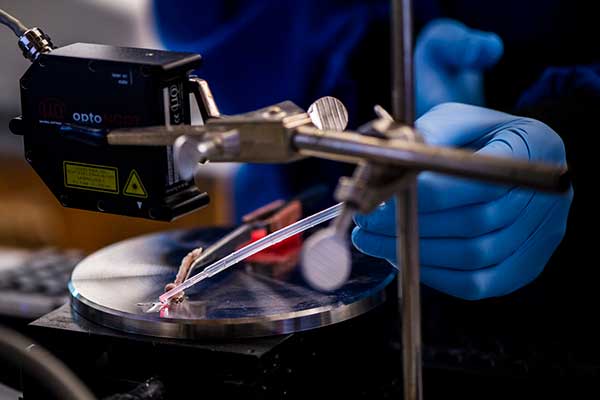How Collagen Could Help Heal Your Torn Rotator Cuff, Achilles Tendon, Meniscus and More

The spinoff company BrilliantStrings Therapeutics of BioE Professor Jeffrey Ruberti and mechanical engineering alum Jeff Paten, PhD’14, made it to the “final four” of the “ARPA-H Dash” competition to accelerate health outcomes. Watch the interview with the final four semifinalists as they describe their research areas (BrilliantStrings Therapeutics starts at 22:07).
This article originally appeared on Northeastern Global News. It was published by Cyrus Moulton. Main photo: Northeastern bioengineering professor Jeff Ruberti studies how collagen effects the healing process on the tissue of a rat bone in the Interdisciplinary Science and Engineering Complex. Photo by Alyssa Stone/Northeastern University
A Northeastern University spinout company focused on the therapeutic potential of collagen has attracted national recognition, finishing in the “final four” of a U.S. government competition that sought the next concept to transform health.
“We just navigated through all the best tech companies in the country,” said Jeffrey W. Ruberti, CEO of BrilliantStrings Therapeutics and a professor in the department of bioengineering at Northeastern.
BrilliantStrings Therapeutics was born out of Ruberti’s Northeastern lab, where he has been studying collagen—the most abundant protein in the body and the building block of connective tissues such as tendons, ligaments, muscle and skin and cartilage—since 2004. Over the years, Ruberti and his students have discovered that collagen is more than just an ordinary protein.
In fact, it’s a “brilliant string,” according to Ruberti. He outlined several major reasons for the protein’s brilliance.
First of all, it becomes resistant under force.
“If I take a bucket of collagen and stretch it, then the collagen forms fibers to resist the stretching,” Ruberti explained.
He contrasted this with a piece of string.
“If you take a piece of string and pull it tight, it’s easy to cut because it just snaps,” Ruberti said. “With collagen, you stretch it and it makes it harder to cut.”
Secondly, collagen seeks out injuries in connective tissues and forms fibers to repair them.
“It’s a material that tries to fix itself,” Ruberti said.
Finally, it is “clean,” according to Ruberti, meaning that if collagen is present someplace it is not necessarily needed, it just breaks down and falls apart.
“The collagen makes the strings in your body and knows what to do,” Ruberti said. “It goes to where you need it, and it doesn’t go anywhere else … You can dump it in and it will fix damaged material, and if it doesn’t, it will disappear.”
Read full story at Northeastern Global News